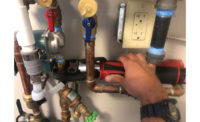College Chooses VRF for Dorms
The board of trustees at Harvey Mudd College (HMC), a private liberal arts college focusing on science, engineering, and mathematics located in Claremont, Calif., instructed its facilities director, Tom Shaffer, to investigate the possible modernization of the 50-year-old HVAC systems in the three oldest dorms. These consisted of hydronic (radiator) heating from a hot water boiler system in each building — and no air conditioning systems. Shaffer’s online research led him to variable refrigerant flow (VRF) zoning technology involving multi-split heat pump systems using multiple indoor units connected to a single outdoor unit. He was interested in the refrigerant piping and heat recovery, ease of installation in old buildings, energy efficiency, and the flexible operation.
After a meeting and complete walkthrough of one of the dorms with a local representative from Mitsubishi Electric Cooling & Heating, Shaffer obtained approval from the board to install a VRF system in one of the halls as a beta test. He enlisted P2S Mechanical Engineers of Long Beach and Sirius Mechanical of Moreno Valley, Calif., to design and install the new system, and unlike many projects, the final bids came in substantially lower than a conventional system.
Randy Scholnick, director of sales for Sirius Mechanical said, “The VRF zoning system allowed for refrigerant line flexibility, remote locating of outdoor heat pumps and individualized zone control with fan coils in each room able to switch simultaneously from cooling to heating.” In addition to providing personalized comfort to each occupant or student, the indoor units were designed to operate as low as 24 dB.
Based on the performance and energy efficiency of the original VRF system, the college installed similar systems in the two other buildings. According to David Dower, assistant vice president, planning and construction, Harvey Mudd College, “The equipment was easy to install in our 50-year-old buildings, and the systems have performed well. We are quite delighted with all these benefits, which have provided a great return on our investment.”
Hybrid Geothermal Part of LEED Platinum Project
The Syracuse Center of Excellence at Syracuse University in Syracuse, N.Y., is a Leadership in Energy and Environmental Design (LEED) Platinum building which includes an array of new technologies including a vapor intrusion system, storm water retention tank, demand controlled ventilation, underfloor ventilation, and radiant ceilings. It also incorporates an extensive hybrid water-source geothermal system using more than 49 300-foot wells in concert with a hydronic condensing boiler system.
When the geothermal system requires supplemental heat, two Fulton Pulse hydronic condensing boilers provide additional energy. The boilers also provide heat for domestic hot water.
According to Dan Brosnan, sales engineer with Comfort Systems, Inc., Syracuse, N.Y., the company that supplied the boilers, “The university is using the Pulse boiler because the boiler is so efficient. It has a small footprint and a fairly robust design without limits for flow rate and return water temperature, making it the perfect boiler for this type of application, where water temperatures range from a low of 28˚F (2˚C) to a high of 90˚F (32˚C).” Brosnan went on to explain, “A conventional boiler would require a secondary loop so that the boiler would never see such low temperatures. But with the Pulse boiler, you can actually run those low temperatures through the boiler without fear of hurting the life expectancy of the boiler.”
The boilers at Syracuse Center of Excellence also operate with a sequencing system called ModSync, which optimizes the operation of the boilers to limit the number of cycles they incur while maximizing the efficiency of the boilers.
“Conventional boilers and control systems bring a boiler on, and once the boiler is operating on its highest firing rate, the control system brings on the second boiler,” explained Brosnan. “Using the condensing boilers, the first boiler is brought on, and once it reaches about 50 percent firing rate, the ModSync brings the second boiler on. Then, both boilers drop to the appropriate firing rate and operate together.”
FAMU Signs Performance Contract
Florida A&M University (FAMU) has chosen Siemens to implement a $12.2 million performance contract that will save approximately $1.2 million in equivalent guaranteed annual energy savings after the company introduced performance contracting to FAMU via a $2.4 million project in 2009. The initial project successfully introduced the energy efficiency and financial benefits of performance contracting to the school.
The new 18-month project aims to partially decentralize FAMU’s obsolete central steam plant heating system and includes a multitude of facility infrastructure improvements including the steam system infrastructure renovation, an advanced solar-thermal heating system for the swimming pool, central chilled-water and steam plant improvements, building automation improvements, and ventilation and dehumidification improvements for the library.
Because plans call for partial decentralization of the steam heating plant and the implementation of other facility improvement measures to campus buildings, energy savings should be very significant. For example, the reduction of natural gas consumption is projected to be 42.6 percent, which represents an annual equivalent savings of $706,204. Electricity consumption is projected to be reduced 12.1 percent, creating some $563,909 in equivalent cost savings on top of reductions and savings that came from implementing the original contract.
Over the 18-month project, 21 area boilers will be installed in individual buildings. According to FAMU administrators, just a small portion of the steam plant project would have required a capital budget expense of more than $5 million — a cost that FAMU would simply not be able to bear without the financial support of the Siemens performance contract. As it stood, the entire steam system was running at a high rate of pressure just to serve one building. Installing area boilers at the dorms and science buildings enables the university to shut down the steam system during the warm weather months (six months each year). Other improvements include chiller plant optimization via Siemens Demand Flow optimization software which will increase chilled-water system efficiency and capacity. Also, to ensure central command and control of the majority of campus facilities, Siemens building automation systems are being installed in 14 buildings.
For more information, go to www.mitsubishipro.com/en/professional, www.fulton.com, and www.usa.siemens.com/infrastructure-cities.
Publication date: 7/30/2012












